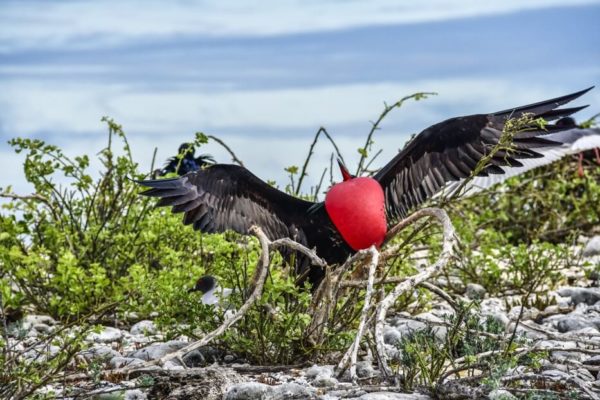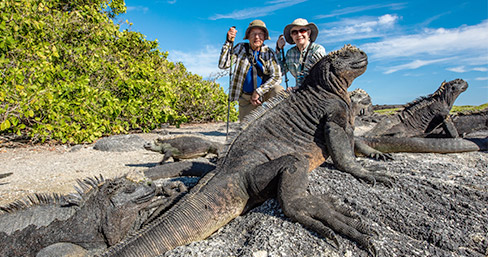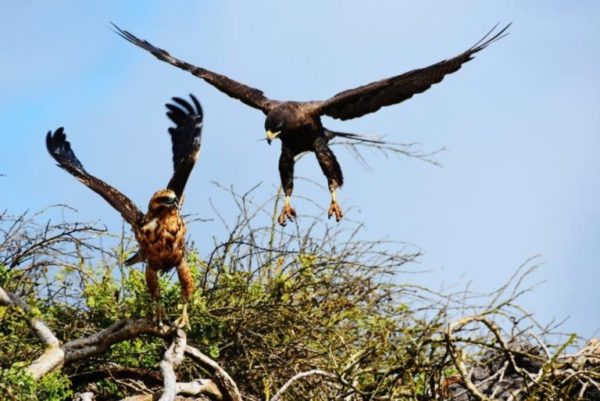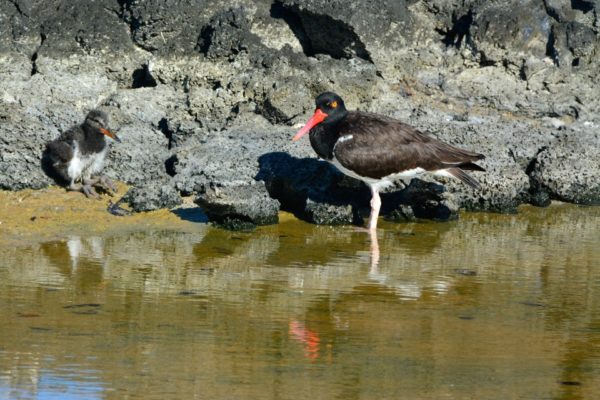Mockingbird Social Network in the Galapagos Islands

Given that its Latin name, mimus, really means “mimic,” mockingbirds are renowned to be very inquisitive and obnoxious birds who can mimic up to 36 different songbirds’ calls and melodies. Though they have been known to land on tourists’ heads and investigate luggage, Galapagos mockingbirds are not known to mimic the cries of other Galapagos birds. Rather, their contribution to Charles Darwin’s development of his theory of evolution has earned them international renown.
Identifying mockingbirds
The Galapagos mockingbird has four species, yet they are all quite similar in appearance overall. In fact, it requires a skilled eye to tell each species apart. Their beaks, which Darwin was most interested in (just like with Darwin’s finches), are the most evident difference between them. The most obvious example of this distinction is between the Hood and Galapagos mockingbirds, where the former has a beak that is much larger and more curved than the latter.
With its black, curved beak and subtle brown and grey streaks decorating its otherwise white plumage, the Galapagos mockingbird is easily differentiated from other birds on the archipelago. They may also be identified by the little white ring that surrounds their eyes and by their black feet and legs.
Where the Galapagos Mockingbirds are found
All four species are covered on the Southern Galapagos Isabela II itinerary in just four nights and five days. Three of the four species are included on the four-night, five-day eastern itinerary of the Santa Cruz II trip and La Pinta. With the exception of Champion (near Floreana), Española, and San Cristobal islands, most of the Galapagos Islands are home to Galapagos Mockingbirds. Every one of these three islands is home to a different species of mockingbird. They live in mangroves and moist woods, although they are most prevalent in drier lowlands with coastal scrub.
Social circles and avian assistants
Among other mockingbird species, the social structure of Galapagos mockingbirds is relatively complicated. The birds are highly devoted to and possessive of their designated region, to which they dwell in social groupings. The birds fiercely protect their area, fluttering their wings and fanning their tails to keep intruders at bay and making loud noises to warn them off.
A group of adult mockingbirds can number up to 24 birds, however the average community size is two to five. Multiple breeding females born in the territory are included in each group, but males predominate over them in terms of both quantity and behavior. In each group, the eldest male assumes the dominating position, and the females are ranked behind the males in a linear hierarchy of dominance.
Breeding

Amazing experiences abound in the Galapagos!
Amazing experiences abound in the Galapagos! [/caption]
Breeding couples in this group are usually monogamous, consisting of two individuals of the same rank, however this isn’t always the case. For instance, the mating system may become polygamous in years when females exceed males; in such a scenario, shared nesting is not unusual. Birds seldom engage in group breeding, which makes its social structure one of its most fascinating features. Although each individual nest is usually occupied by a breeding pair, the birds as a whole guard the area. Moreover, it is not unusual for several “helper” birds to support a breeding couple as they raise their young, including providing food for the chicks. Though it has been shown that nests receiving assistance fledge their young earlier than those without, the additional support has no effect on the fledglings’ pace of development.
Despite a number of research, specialists are still unsure of the exact cause of this collective breeding. It is obvious that the father bird benefits from aid from a helper bird as it means he needs to gather less food for the young. It’s also conceivable that the mother gains something from this practice, which might lead to her having additional children in the future. But what’s in it for the auxiliary birds? Given that the helpers are usually older offspring of the breeding couple, it is probable that they participate in chick raising in order to guarantee that as many of their genes are passed on to the next generation.
However, due to intense rivalry for territory expansion, joining an existing territory, or finding a mate, young male mockingbirds may choose to remain with their parents and help with chick rearing. The sex ratio is usually slanted towards males, with around one-third more males than females, which does not aid the mockingbirds, which fiercely defend their territory, especially during mating season. Whatever the motivation behind this collaborative breeding, it is a remarkable adaptation to live in the Galapagos, where climatic variations may be fairly significant owing to El Niño-related oscillations.
Mockingbirds are known for being quite curious and pesky birds, able to imitate the songs and call notes of up to 36 other songbirds (their Latin name mimus actually means ‘mimic’). However, while Galapagos mockingbirds are certainly extremely curious, even landing on tourists’ heads and exploring backpacks, they are not known to imitate the calls of other Galapagos birds. Instead, they are renowned worldwide for their role in assisting Charles Darwin to form his theory of evolution.
Spotting mockingbirds
The Galapagos mockingbirds can easily be distinguished from other birds in the archipelago due to the delicate brown and grey streaks that decorate its generally white plumage, along with its black, curved beak. They can also be recognized by their black legs and feet, and the delicate white ring around their eyes.
There are four species of Galapagos mockingbirds, and in general terms, they are all very similar in appearance; in fact, it takes a trained eye to be able to differentiate each species. The most obvious difference is in their beaks, the object that most caught Darwin’s attention (similar to the case of Darwin finches). This difference is most clearly seen between the Hood mockingbird and the Galapagos mockingbird, with the Hood Mockingbird having a significantly longer and more curved beak than that of the Galapagos mockingbird.
Social groups and helper birds
Galapagos mockingbirds have quite a complex social organization, not altogether common among other mockingbird species. The birds live in social groups within a determined territory, to which they are strongly attached and territorial. The birds avidly defend their territory, fanning their tail and flicking their wings away from their body, while producing loud calls to scare away intruders.
A community of mockingbirds typically consists of around two to five adult birds but can reach anywhere up to 24 adults. Each group includes multiple breeding females that were born in the territory, but males in both number and behavior generally dominate them. The groups form a linear dominance hierarchy with the oldest male taking the dominant role, and the females ranking below the males.
Breeding

Galapagos is full of WOW moments!
Among this group, breeding pairs are typically monogamous, formed by two individuals of equal rank; however, this is not always the case. For example, during years in which females outnumber males, the mating system may become polygamous, in which case it is not rare to see joint nesting. One of the more intriguing characteristics of this social structure is the practice of collective breeding, which is quite rare among birds. A breeding pair typically occupies their own individual nest, but all of the birds defend the territory collectively. Furthermore, it is not uncommon for multiple ‘helper’ birds to assist a breeding pair in rearing their young, even bringing the chicks food. This additional help does not affect the growth rate of the fledglings, but it has been found that those nests that receive help fledge younger than those that do not.
Although several studies have been carried out, experts are still not entirely sure why this collective breeding occurs. The benefit to the father bird is clear: assistance from a helper bird reduces the amount of food he must acquire for the young. Furthermore, it is also possible that the mother benefits from this practice, potentially producing more chicks throughout her life as a result. However, what is the benefit for the helper birds? It is possible that the helpers take part in chick rearing to ensure that as many of their genes as possible are passed on to the next generation since the helpers are typically older offspring of the breeding pair. On the other hand, young male mockingbirds may stay with their parents and assist them in chick rearing because of the level of competition in establishing new territories, joining a different territory or gaining a mate. Mockingbird defends vigorously their territories, especially during their breeding season, and it does not help that the sex ratio is typically biased towards males, with approximately one-third more males than females. However, no matter the reason for this collective breeding, it is an excellent adaptation to living in the Galapagos where the climate can vary quite greatly due to fluctuations such as El Niño.
Where to find Galapagos mockingbirds
The Southern Galapagos Isabela II itinerary includes all four species in merely four nights, five days. Eastern itineraries of Santa Cruz II cruise and La Pinta, with four nights, five days, include three of four species. Galapagos Mockingbirds can be found on the majority of the Galapagos Islands, except Champion (close to Floreana), Española and San Cristobal islands. These three islands, each harbors its own species of Mockingbird. They are particularly abundant in arid lowlands that have coastal scrub; however, they also inhabit mangroves and damp forests.
RELATED STORIES

Interesting facts about the three types of boobies in the Galapagos

Food on a Galapagos Cruise: We’ve Got You Covered

My Favourite Sea Turtle Experience Aboard the Santa Cruz II

First Day Aboard the Santa Cruz II

North Seymour Frigates and Boobies

Ecuador Facts (Vol. I): An Interesting Collection of Natural Wonders and Achievements

Galapagos Experience Testimonial

Galapagos Frigatebirds: A Colorful Medley of Courting & Nesting

The Beauty of an Intimate Galapagos Vacation

A Synopsis of Galapagos Plant Life’s History

Hidden in Plain Sight: The Galapagos Baby Oystercatcher
